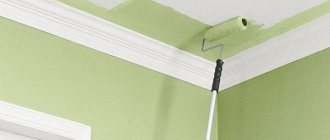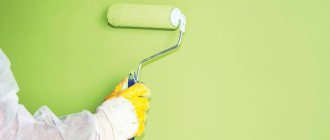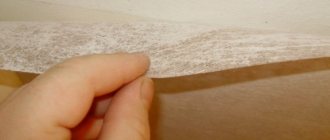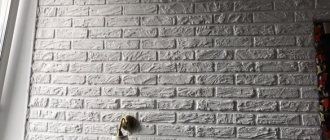Paint is one of the simplest and most effective interior design options. To use this building material, no special equipment or professional skills are required. In the modern paint and varnish industry, there are a huge number of varieties of wall paints. On the one hand, this is good, and the client has the opportunity to choose from a really wide range. On the other hand, because of this diversity, customers who are not familiar with the subject of paints and varnishes have difficulties and confusion when choosing.
Features of interior paints
Modern paints are easily and quickly applied to the surface, are resistant to fading, and dry quickly. Interior paints are used as a decorative and protective treatment in rooms for various purposes. They are used to cover wooden walls, concrete, brick, structured surfaces, and for wallpaper intended for painting.
The main thing is to choose the right paint so that the new repair lasts as long as possible.
Mechanized versus manual labor
It is no secret that today in most cases the manual method of applying interior paint to walls using rollers is used. This is understandable if we remember our earlier statement that most people consider painting one of the simplest ways to decorate walls, why unnecessary mechanization?
However, applying paint by spraying has a number of certain advantages:
Advantages and disadvantages of paints for interior wall decoration
Advantages:
- Environmental Safety.
- Resistant to fading, long-term color retention.
- They dry quickly and have virtually no odor.
- Resistant to cracking, forming a reliable and durable layer.
- They have fairly good hiding power, which in turn helps create an ideal coating.
- Universal compatibility allows you to paint various surfaces: from plaster to paintable wallpaper.
Paint can change any apartment beyond recognition.
Disadvantages of interior paints for interior wall decoration:
- The surface to be painted requires leveling and preparation. Otherwise, all defects will be visible even under several layers.
- Any mechanical impacts can lead to damage to the decorative coating.
- Some paint compositions have low vapor permeability, which can lead to the formation of condensation. To avoid excessive humidity, forced ventilation is installed in the room.
You can always choose a material that meets your individual needs.
The best water-soluble compounds
The popularity of this paint is due to its low cost and practicality:
- it dries quickly;
- Can be easily painted in any color using a pigment;
- does not smell;
- Suitable for most grounds.
The disadvantages of inexpensive emulsions are poor mechanical resistance, rapid contamination, and fear of moisture. This material is only suitable for painting ceilings in rooms with normal humidity.
Interior emulsion "Universal" from "TEX"
For painting walls in the bedroom, living room, nursery and other rooms with normal humidity levels. After drying, a vapor-permeable coating with a matte effect is formed on the surface of the walls. The paint adheres well, evenly covers concrete, plastered, brick, wood and plasterboard substrates, and is economical in consumption. Initially white paint can be tinted to any shade if necessary.
pros
- environmental friendliness;
- does not smell;
- quick drying;
- economical consumption;
- affordable price;
- does not form splashes or drips.
Minuses
- not suitable for rooms with high humidity.
Interior emulsion “Profi” from “TEX”
A multifunctional composition that can be used in rooms with dry and humid microclimates - kitchen, bathroom, bedroom, living room, children's room. After the paint dries, a “breathing” and very durable, wear-resistant layer is formed on the surface of the walls. Suitable for most types.
pros
- can be tinted;
- hiding power;
- has no smell;
- dries quickly;
- economical consumption;
- does not form splashes or drips.
Minuses
Interior emulsion from LAKRA
Water-dispersion paint forms a matte, uniform coating after drying. Available in white. Can be tinted in light shades. 1 kg of paint is enough for an average of 6-8 m2. It is used for painting walls in rooms with normal microclimate and humidity. Excellent coloring of porous surfaces.
pros
- economical consumption;
- durable front layer;
- adhesion to the base;
- can be washed.
Minuses
- there is a smell.
Paint "Vinyl Matt base BW" from "Dulux"
After drying, it creates a deep matte finish on the surface. It is characterized by high smoothness. Masks the imperfections of the base. Can be tinted in any shade according to all current catalogs. The paint is easy to apply, does not leak or splash.
pros
- does not smell;
- can be washed;
- lays down evenly and masks imperfections in the base.
Minuses
- high price.
Why do you need to paint the walls in your apartment?
In modern renovations, new generation interior paints are used. Now covering walls and ceilings with paints is long-lasting and reliable protection. In order for the dye to adhere reliably and the coating to last for many years, it is important to choose the right composition, taking into account the structural features of the material being painted.
As a decorative covering for walls, it can be of various types in terms of color, texture, and degree of gloss.
Paints will help revive the interior and complement it with bright accents, creating a unique charm and emphasizing the individuality of the style.
More expensive than matte
The more gloss the paint offers, the more it will cost. Semi-gloss paint is made with more binders (resins responsible for shine) than, for example, satin paint. Binders are needed to provide the beautiful shine and durability for which it is famous.
Shades Manor House Gray No. 265, Cook's Blue No. 237, Calamine No. 230, Green Blue No. 84, Babouche No. 223, Down Pipe No. 26, Pointing No. 2003, Modern Eggshell, Farrow & Ball
Types of paints for indoor walls
Regardless of film formation, almost all high-quality interior paints are classified as water-based (water-dispersed). They must contain environmentally friendly components and a limited amount of organic compounds. Taking these features into account, many manufacturers produce a range of washable and wear-resistant dyes for interior use.
In addition to its aesthetic properties, paint can be used as a means to protect surfaces from certain environmental factors.
Paints by type of composition
The term “interior” is most appropriate for water-based paints. These also include emulsion, water-dispersion and latex (latex dispersion, acrylic-based water-dispersion).
Ingredients of water-based dyes:
- all kinds of functional additives: preservatives, thickeners and others;
- connecting elements;
- fillers;
- pigments;
- plasticizers.
Paint is a universal coating. It can be used to decorate the interior of the house.
Water-based dyes are non-toxic and breathable, but have poor moisture resistance because their surface has a porous structure. In turn, moisture, penetrating the pores, destroys the protective properties of the paint. Therefore, this variety is best used for a living room, children's room or bedroom. It can be used in the toilet, bathroom or kitchen to paint the ceiling, additionally using antiseptic impregnation.
This paint dries quickly and has no odor.
Water-based paints contain water instead of a solvent, so they are not resistant to moisture and acrylic is added to them to increase moisture resistance.
Based on the binder (film former), several compositions are distinguished.
Acrylic
Water-based with acrylate polymer: the paints are odorless, environmentally friendly, vapor-permeable. They are characterized by a high degree of hiding power, which ensures the strength and resistance of the coating to abrasion and washing using household chemicals. Thanks to quick drying, it allows the use of the room even during the painting process.
Designed for use in residential and public spaces. Acrylic enamel is also suitable for painting wooden surfaces.
Acrylic paint leaves a hard film after drying and is suitable for covering any surface: wood, plastic, metal, brick.
It is not recommended to paint the bathroom, as with constant humidity, it loses its properties, which can lead to the formation of mold. For rooms with high humidity, acrylic paint with antiseptics is suitable.
Only components such as acrylates can give the coating the best appearance combined with strength and quality. New copolymers and artificial latexes developed in combination with functional additives allow these types of paint to increase the uniqueness of their properties: the ability to reduce stains, resistance to mechanical stress and antibacterial properties.
It is damage-resistant, moisture-resistant, dries quickly, does not emit a strong odor, is resistant to sunlight and has a long-lasting color.
Silicone
Silicone pigments are a modern type of paint and varnish materials. Deep matte paint, intended for covering indoor walls and ceilings, is resistant to abrasion, mechanical damage and household chemicals, and can be washed multiple times. It does not contain harmful solvents or plasticizers. Has a certificate of environmentally friendly products.
Silicone paints are more often used for external work or in rooms with high humidity: in the kitchen, in the bathroom.
Silicone has high water repellency and breathability, and is also dirt-repellent. Great for painting bathroom walls. It is used in both residential and public spaces, and is indicated for use in children's rooms.
Silicone paint retains its original color for a long time even when exposed to sunlight, so it can be safely used in rooms with large windows located on the south side.
This paint has a high level of vapor permeability. In addition, it can hide some unevenness on the wall, correct small cracks and chips.
Latex
Rubber-like polymers combined with an aqueous emulsion: latex based on synthetic resins. During the drying process, it forms a dense, high-quality coating that is resistant to external and mechanical influences.
After drying, latex paint leaves a film on the wall that covers any relief.
It does not have a strong odor, which allows painting the premises without relocating people. It is used for finishing residential and public premises.
Silicate
It consists of a mixture of pigments and fillers with a water-based liquid glass solution, which, when dried, forms a durable decorative, protective and water-repellent coating.
All water-based paints are vapor permeable and easy to clean.
The paint is intended for interior and exterior use, but it is used extremely rarely for interior decoration of residential premises. The process of applying paint is quite labor-intensive; in addition, the composition of the paint requires the preparation of a solution immediately before painting the room.
By properties
What important additional characteristics may different types of wall paints have?
Eco-friendly
Low in VOCs (volatile organic compounds) and virtually odorless, making it suitable for people with sensitivities.
Washable
This wall paint is capable of maintaining shine and color for a long time thanks to modifiers, and can withstand the tests of modern household chemicals. It washes very well and fits on almost any surface.
It is suitable for periodic washing with a damp cloth and soapy water.
Moisture resistant
The most important property of paint and varnish coatings is not to lose their properties as a result of water absorption.
Vapor permeable
The ability of paints to transmit water vapor contained in the air. Vapor permeability and water resistance guarantee a favorable indoor microclimate.
Covering power of paints
This is the ability of paints and varnishes, when applied to a surface, to hide the previous color or very minor flaws.
This paint is durable, practical, and can be used for both external and internal work.
The greater the hiding power, the better the coloring, the less paint consumption.
UV filter and color fastness
To prevent the harmful effects of ultraviolet radiation, special substances are added to the paint that absorb it. This is how acrylic paints retain their color for a long time thanks to UV mesh acrylic resins.
By invoice
Interior paints are also divided depending on the degree of gloss (gloss).
Matte
It is characterized by its lack of shine and is subject to gradual washing and abrasion. It is better to use for uneven surfaces - it hides imperfections.
Matte wall paint is widely used when decorating residential premises.
Semi-matte
A universal type of paint. The semi-matte type is great if you need to emphasize something in the interior, without focusing too much on it at the same time.
Semi-matte has a low level of gloss, like an egg shell.
Glossy
Compared to matte ones, they look good only on a smooth surface. Glossy paints visually increase the space, because with them all the irregularities become more obvious. When applied to the wall they appear darker.
Glossy paint in the interior offers unique opportunities to increase and decorate the space.
Texture
This type of paint can be used to decorate the surface of walls, creating three-dimensional effects.
Textured paint is a decorative coating based on acrylic and polymer components that give the surface a beautiful relief appearance.
Stages of applying decorative coating
To work, you will need a brush with natural bristles, a spatula, a scraper, a foam roller, a container for the roller, and a wet cloth to remove drips.
When preparing the surface for painting, uneven surfaces are smoothed out using a spatula, and sagging and drips are removed with a metal scraper. Cracks, chips, potholes are carefully sealed with cement mortar, alabaster, and after drying, the areas are treated with sandpaper.
- Sockets, switches, lighting fixtures must be removed and wires insulated.
- Cover the prepared and even surface with a primer, the shade of which matches the color of the paint.
- Painting begins with hard-to-reach places, corners, sockets, batteries. These areas are carefully passed with a brush.
- A flat section of the wall is painted with a roller or spray gun. After applying the base layer, after it dries, re-painting is carried out.
Paints with organic fillers, textured and decorative ones must be thoroughly mixed, as the fillers settle to the bottom. When painting large spaces, use a construction mixer.
Among the variety of paints and varnishes, preference should be given to trusted manufacturers. Among the sales leaders on the European market is the Tikkurila brand.
Tikkurila interior paint is of high quality and affordable prices.
Color palette
The palette of most manufacturers is quite diverse, which makes it easy to choose not only the desired color, but also its shade.
In addition to colored ones, the construction market offers paint options available only in white. In addition to these types, liquid dyes are produced, adding which in a certain proportion, you can obtain the necessary colors and shades. So, by adding colored black pigment in various proportions to the main white paint, you can get many shades: from light gray and gray to dark and black. Sometimes this role is played by pigments, and among them there are toxic ones: red lead – orange, lead + zinc – yellow, chromium oxide + manganese – green.
When choosing paint and varnish products in a store, it is important to initially imagine the desired effect, the future room and how the new paint will look in the interior.
Transparent paints are used for protection. They can be shiny or matte, and can shade or emphasize the noble structure of the base.
Mixing technique
Before you start tinting, it is worth determining how much color and paint you will need. When preparing by hand, it is difficult to get the same color the second time as the first time. To avoid such moments, calculations are made and exact proportions are determined.
To avoid spoiling all the material, first mix a test color.
100 ml of paint and a few drops of pigment are added to a small container. It is better to dose with a special syringe: this will help you find out the exact amount. Color should be added until the desired shade appears.
Next, the resulting sample is rolled out on the wall, since the color often changes on the working surface. You need to wait until the paint dries and look at the shade in different lighting. If the palette suits you, work continues.
To make a large volume, take a bucket and mix the mixture with a construction mixer. The paint is diluted with water and colors are added to it.
To paint the entire surface of the wall, the number of calculated pigments is reduced by 20%. That is, if 100 ml required 10 drops of solution, then 1000 ml will require 80. The tinting composition is added in small portions to the bulk.
Comparison of paints for interior walls
Moisture-resistant paint reliably resists the effects of high humidity without changing its appearance, maintaining all its qualities. It can be used to paint walls in the kitchen or bathroom; it is very convenient in children’s rooms where little artists grow up; it will also not be out of place in the hallway and living room. Resistant to mechanical damage, washes well.
Sharp transitions and experiments are well suited for living rooms or children's rooms; for the bedroom it is better to choose calmer solutions.
There is quite a large selection of hydrophobic paints; they are used for various surfaces: stone, wood, plastic and other materials. However, in order to choose the right composition, you need to have an idea of the capabilities of certain types of paints. Simply irreplaceable in the interior of an apartment.
How to choose paint for a certain type of room
There is no single universal composition suitable for use in all rooms of the apartment. Dyes with low moisture resistance are perfect for a living room, bedroom or nursery. The same cannot be said about the bathroom - formulations with increased protection against moisture are needed here.
Well-known and trusted brands value their reputation and try to produce truly high-quality products, producing both luxury and budget options.
Moisture-resistant paints are more expensive, but their use in rooms with high humidity is well worth the additional expense. Thanks to moisture-resistant dyes, the service life of plaster and drywall is extended.
Popular vote
What paint would you choose or recommend?
"Vinyl Matt base BW" from "Dulux"
0.00 % ( 0 )
"LAKRA"
23.08 % ( 3 )
"Profi" from "TEX"
7.69 % ( 1 )
"Universal" from "TEX"
7.69 % ( 1 )
"Weiss" from "ECO"
0.00 % ( 0 )
"PL-07A" from "Profilux"
0.00 % ( 0 )
"Joker" from "Tikkurila"
7.69 % ( 1 )
"Alpina Renova"
0.00 % ( 0 )
"Optimum"
0.00 % ( 0 )
Litotherm Paint Sil from LITOKOL
7.69 % ( 1 )
"Euro Extra 20" from "TIKKURILA"
7.69 % ( 1 )
"Caparol" "CapaSilan"
15.38 % ( 2 )
"Retail Eurolatex 7" from "Dufa"
7.69 % ( 1 )
Bindo 7 BW by Dulux
0.00 % ( 0 )
3D White by Dulux
7.69 % ( 1 )
"Retail Eurolatex 3" from "Dufa"
7.69 % ( 1 )
What you should pay attention to when buying modern paints
The first thing you need to pay attention to is the manufacturer, environmental friendliness, hiding power, moisture resistance, drying time, presence of odors. Then, based on the purpose of the room, select paint with the appropriate parameters.
Buyers consider companies from Europe to be the best manufacturers.
Useful tips for choosing paints
- When selecting, you should pay attention to compatibility with other dyes and surfaces to be painted.
- If you need to select a putty, primer or solution to remove old paint, you must take into account their composition and compatibility in order to avoid unforeseen situations.
- To protect against corrosion, temperature changes, exposure to various microorganisms, mold and mildew, paints with antiseptics and special impregnations are required.
Criterias of choice
To avoid mistakes when choosing, let's consider what to pay attention to.
- Price. Some, of course, wanting to save money buy inexpensive models. But it is worth remembering that the manufacturer, in pursuit of low costs, does not always correlate products with GOST standards and certification. Therefore, the price range should be correlated with other selection parameters.
- Covering power. It is better that the result is achieved in one coating. If 2-4 layers are applied, this will entail additional paint costs and a long drying time.
- Durability. A positive quality will be the properties of dust and moisture resistance. Then the color will not fade or fade over time.
- Material. Correlate with the surface and the room itself where you will use it. Not all paints are suitable for different surfaces. The humidity indicator is also important to consider. Not all paints and varnishes can withstand temperature changes or high humidity.
- Environmental friendliness and safety. It is especially important if you are choosing for a nursery or bedroom. Choose one that meets standards, GOSTs and is environmentally friendly.
- Manufacturer. Which company is better to choose will depend on preferences and finances. Some manufacturers supply premium paint, which of course will have high technical features, while some produce inexpensive, budget models, in accordance with production standards and parameters.
Rating of brands of wall paint manufacturers
- Caparol is a brand that produces washable acrylic-based paints. They are versatile, have double coverage, dry quickly, are odorless and are suitable for all types of spaces.
- Sadolin bindo is a brand of latex paints for all surfaces. A special coloring pigment allows you to maintain color for a long time.
- Kolorit are acrylic-based dyes, indispensable in rooms with high humidity.
- Eskaro - intended for use only in dry and well-ventilated or ventilated areas.
- Joker Tikkurila is an acrylic-based latex paint that can be applied to any paint, has a wide range of applications and can be used in any type of room.
- Belinka latex is ideal for the bathroom, kitchen, hallway and other rooms.
Italian brands take the leading positions in consumer reviews. This paint is considered to be of the highest quality, rich in color, and durable.
This rating and the extensive information in the article will help you choose wall paint that best suits the renovation requirements, as well as the design ideas of the room.
Video
https://www.inmyroom.ru/posts/9193-9193-kak-vybrat-tsvet-kraski-dlya-sten-sovety-ot-dizaynera-inny-usubyan
https://www.caparol.ua/ua-ru/o-kompanii/novosti-kompanii/top-9-oshibok-pri-pokraske-sten.html
https://www.aif.ru/realty/house/kak_pravilno_vybrat_krasku_dlya_sten_v_kvartire
https://www.ivybush.ru/kak-vybrat-krasku-dlya-sten
https://mr-build.ru/materiali/tsveta-kolera-dlya-pokraski-sten.html
https://remoo.ru/steny/kak-vybrat-krasku-dlya-sten-v-kvartire-osnovnye-vidy-i-svojstva











